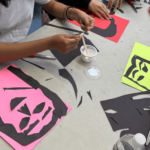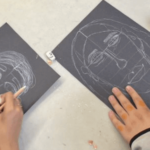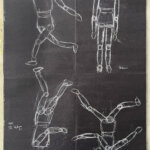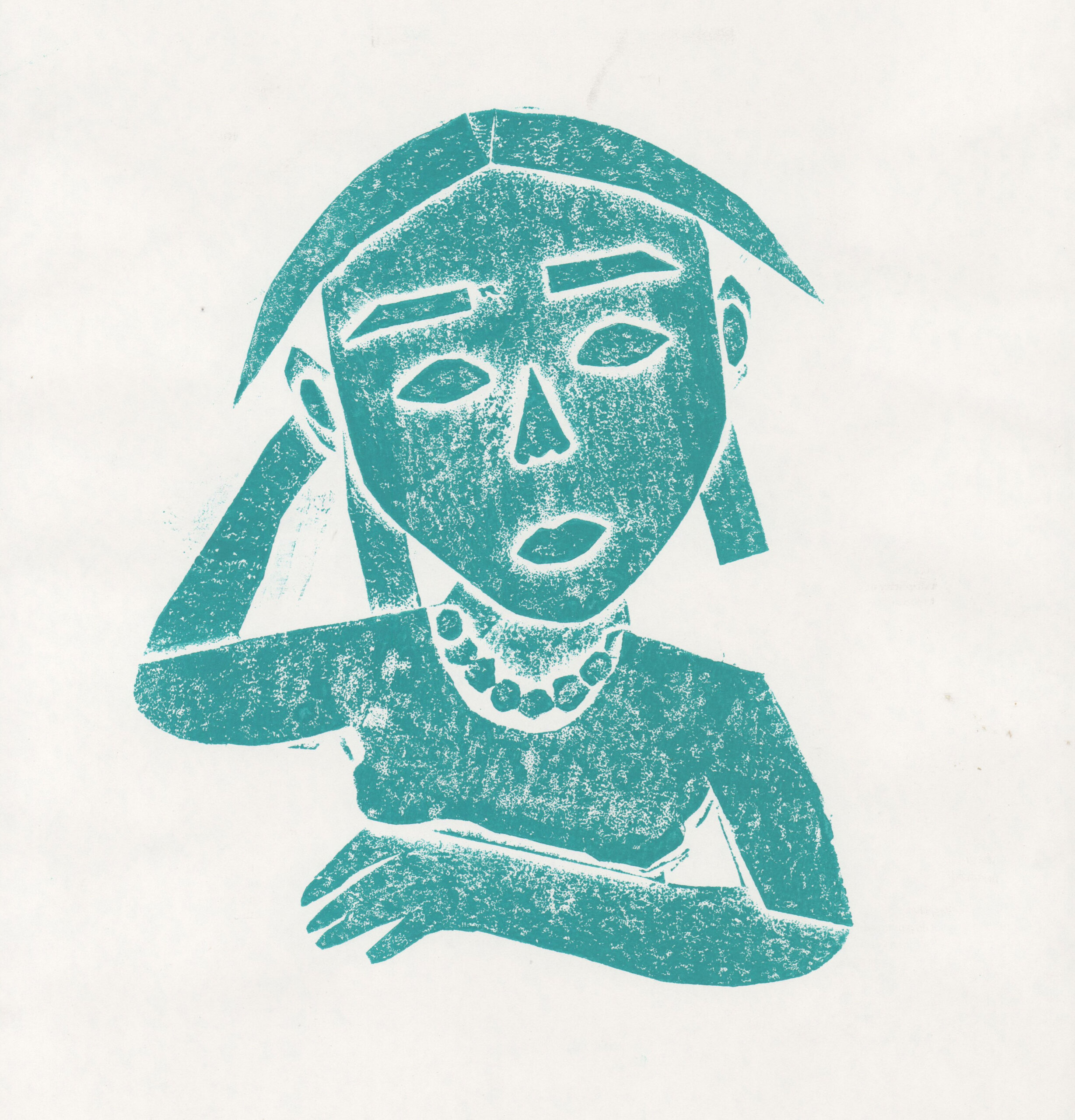Collagraph portraits
Inspired by a selection of works by American Artists with Disabilities
Overview
In this unit, students will look at a variety of works of art created by American artists with disabilities that show a range of approaches to portraiture and the figure. Students will create a full body collagraph print of a person they admire that conveys their individuality through pose, facial expression and details. Students will explore collage techniques, draw a figure from a reference image, create a figurative collagraph plate and make a series of prints.
Grade Level
6-8 (may be adapted for use with other grade levels)
Media
Drawing and Collagraph Printing
Theme/ Big Idea
Artists can use collage techniques to create collagraph prints of someone they admire.
Essential Questions
- How can we honor someone through our artwork?
- How can we represent the unique qualities of an individual through full-body portraiture?
Lessons
Materials and Tools
- Scissors
- Glue (Elmer’s Glue All is recommended)
- Small deli cups (for glue)
- Popsicle sticks (for spreading glue)
- 9×12” construction paper or fadeless paper in a variety of colors
- 9×12” and 12×18” paper, black
- 12×18” newsprint
- 12×18” paper, gray (optional—other colors if desired)
- 9×12” oaktag
- White charcoal pencils
- Oil pastels or crayons
- Block printing ink
- Trays for ink
- Brayers
- Masking tape
- Paper towels
Objectives
Students will:
- Gain inspiration from the work of diverse artists with disabilities
- Engage with different approaches to representing the figure
- Represent a person who is meaningful to them
- Understand the collagraph printmaking process
- Create a collagraph print that shows thoughtful attention to shapes and detail
Note to Teachers
This unit introduces artworks by American artists who have a disability. A disability is any condition of the body or mind that changes the way a person does certain activities and interacts with the world around them. There are many different types of disabilities, such as intellectual, physical, sensory, and mental illness.
A disability is part of an artists’ culture and influences the way that they work and see the world. For some artists, their disability may be an integral part of their identity that is a focus of their artwork. They may make work about having a disability or share the experience of having a disability.
Other artists may identify as an artist first, and a person with disabilities second. Their art may not reflect the experience of having a disability in an easily discernible way.
Many of the artists included in this curriculum have worked with progressive art studios for artists with disabilities, such as Creative Growth in Oakland, CA. Creative Growth Art Center was founded 1974 in Oakland, California at the height of the disability-rights movement. Creative Growth is a nonprofit organization serving artists with physical and cognitive disabilities. View the following video to learn more about Creative Growth and the artists who work there. This segment explores the idea that artmaking is a fundamental human practice and should be accessible to all. (A guide to this resource with follow-up questions is included with this unit.)
Creative Growth Art In “San Francisco Bay Area”
Following the model of these centers, this curriculum does not include biographical information about the artist or their specific disability, unless this is addressed by the artists themselves. It is the role of the artist themself to create context for their work and the focus of looking at the artwork should not be on the artists’ disability, unless the artist or their work explicitly addresses disability.
However, in the context of teaching about these artists it is important to mention that the included artists have disabilities so that the curriculum may serve the following goals (taken from Grow With Give):
- As a mirror—reflecting and amplifying student’s identities or experiences,
- As a doorway—introducing new experiences, identities and experiences that differ from student’s own,
- As an amplifier—implying value, and importance.
The introduction to Lesson 1 will introduce the overall unit so that students may think about and discuss the context for the included work.
Throughout the unit, adaptations and alternative ways of working are included in order to make each lesson accessible to students with disabilities.
These are some additional terms and language that may be helpful as you discuss disabilities throughout this unit (The Art of Education):
Disability: Any condition of the body [physical] or mind [cognitive] that makes it more difficult for the person with the condition to do certain activities and interact with the world around them.
Disability aesthetics: Art that challenges historical notions of beauty as associated with an ideal form or healthy body.
Disability Art: A genre of art where artists “share the experience of disability” in their work for an educational purpose or to promote a change.
Artists with a disability: People making art who have a disability, such as the glassblower, Dale Chihuly, who has a loss of vision, shoulder injury, and mental disabilities.
People First Language: Puts the person before the disability and describes what a person has, not who a person is.
Identity-First Language: Puts the disability before the person in recognition that the disability is an inherent part of the individual.
Ableism: Discrimination in favor of able-bodied people.
Social model of disability: a way of viewing the world, developed by disabled people.
We hope that this unit is only a starting point and that you are able to include art created by artists with disabilities and showcase disabled artists throughout your curriculum.
On Using This Unit
Sample Language
The lessons are written with sample language you may use with your students as you teach. Within each lesson, scripted text is italicized, while normal text includes directions and other lesson components.
Teaching With Works of Art
Before teaching with a work of art, spend some time looking closely at it on your own. Familiarizing yourself with the artwork will prepare you to guide the close-looking activity.
If your students are new to looking at art together, you can introduce the activity to students in the following way:
Today we are going to spend some time looking at and discussing a work of art together. When we look at art, there are no right or wrong answers. I’m going to ask you to look closely, share your ideas about what you see, and listen respectfully to each other’s ideas. Everyone’s ideas are important. We all see things differently, and when we look at art, we can learn to see through each other’s eyes.
Resources
Educational Resources:
Creative Growth is a non-profit organization based in Oakland, California that advances the inclusion of artists with disabilities in contemporary art and strengthens the community by providing a supportive studio environment and gallery representation.
Grow with Give is an online educational resource made by teaching artists for teaching artists. GIVE provides educators with strategies for creating liberated learning environments for diverse students.
New York City Centers for Artists with Disabilities:
LAND Studio and Gallery, Brooklyn, NY
Pure Vision Arts, Manhattan, NY
Curriculum Connections
The National Disability Arts Collection and Archive The National Disability Arts Collection and Archive is an online resource housing upwards of 35000 art works, films, articles and exhibitions displaying the history of disability arts and disability studies across the United Kingdom.
Art in the Twenty First Century: Educator’s Guide to Season Nine
This guide provides information and context on Creative Growth and the artists introduced in the video as well as discussion questions for viewing.
NYC Blueprint Strands Addressed
#1 Artmaking
#2 Developing Visual Arts Literacy
#3 Making Connections through Visual Arts
#4 Community and Cultural Resources
#5 Careers and Lifelong Learning
Credits
Written by Andrea Burgay, Associate Director of Programs and Curriculum
Research and design support from Joelle Charles, Senior Coordinator of Teaching and Learning
Nicola Giardina, Director of Teaching and Learning
Hasna Muhammad, Ed.D., Chair, Board of Directors, Studio in a School Association
Alison Scott-Williams, President, Studio in a School NYC
Copyright © 2023 Studio in a School NYC LLC










